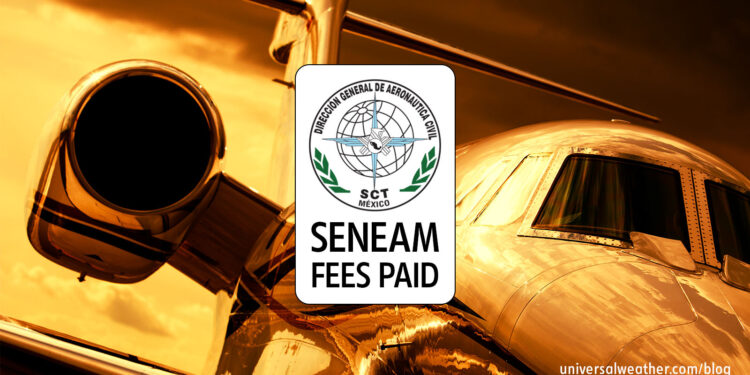SENEAM Fees for Travel to or over Mexico – Part 2: Dealing with a SENEAM Suspension

This business aviation blog post continues from our article last week, entitled “SENEAM Fees for Travel to or over Mexico – Part 1: Calculating Fees & Managing Payments.”
When applying for a Mexican permit, you will not be notified of any outstanding Servicios a la Navegacion en el Espacio Aereo Mexicano (SENEAM) fees. Direccion General de Aeronautica Civil (DGAC) only processes landing permits and is not notified in advance of business aircraft operators on the suspended list. However, if you’re on suspension, you’ll be turned away at the flight information region if attempting to fly over Mexico. If you’re landing in Mexico, they’ll allow you to enter the country, but the comandante will detain you on the ground until outstanding SENEAM fees are settled. Both of these scenarios can be avoided by having your 3rd-party provider check on any outstanding SENEAM fees prior to day of operation.
The following is an overview of what you need to know:
1. SENEAM suspension list – not publicly available
SENEAM keeps a list of suspended operators for internal use, and this list is not publicly available. This suspension list normally has over 300 foreign-registered aircraft with overdue SENEAM fees dating back to 2002. Be aware that SENEAM does not notify operators of a suspension. You may not find out about this until you’re denied entry into Mexican airspace. If you’ve landed in Mexico and are determined to have been suspended, the airport comandante will not let you depart until outstanding fees are settled. Suspension lists are updated on a regular basis, and your 3rd-party provider can check to determine your status on this list.
2. Suspension details
To determine if you have outstanding fees due, you or your 3rd-party provider can contact SENEAM to determine if your aircraft or operator name is on the suspension list. SENEAM will advise what outstanding fees, if any, are due. The suspension list is comprised of both tail numbers and operator names. In some cases only the operator name will be on the list, but you can presume that all aircraft under the operator name are suspended. Be aware that if an operator name is on the list, including that of an operator of a multi-aircraft managed fleet, the entire fleet will be barred from using Mexican airspace.
3. Detention on the ground
If it’s determined that your aircraft is on suspension, you’ll be held on the ground in Mexico until outstanding fees are paid. Once nav fees are settled and processed, and SENEAM receives confirmation of this, they’ll forward a “request for release” through various channels, prior to the airport comandante receiving a release approval. The problem is that if one of these channels experiences a delay, the whole process stops in terms of the comandante receiving your release order. We’ve seen cases – particularly on Fridays, weekends, and holidays – where suspended aircraft are held on the ground for quite some time.
4. Sale/purchase of an aircraft – new owner is responsible for payment
When an aircraft is sold, the new operator is responsible for any outstanding SENEM fees. SENEAM’s position is that it’s the responsibility of the new operator to determine any outstanding fees at the time of acquiring the aircraft. So, it’s always important to ensure that you’re aware of any outstanding SENEAM fees when purchasing an aircraft. It’s best to notify SENEAM whenever you have changes to your fleet, especially when purchasing a new aircraft that may be on the list.
5. Settling overdue fees
Even though SENEAM fee collections were not enforced until 2012, outstanding fees going back to 2002 will be charged retroactively to any operator found to have use the airspace during that time period. So, if you owe SENEAM fees – even if you’re just a month late in payment – you’ll need to pay all SENEAM fees due since 2002, along with late fees and “actualization fees.” Actualization fees are the difference between what the fee due was at the time the aircraft used the airspace and today’s current SENEM fee. Not only can this be an expensive proposition, but there’s also considerable calculation involved. Once overdue SENEAM fees are settled, the suspension is lifted, but suspension lists are not always updated quickly. It’s important, therefore, to keep copies of receipts and bank transfers to SENEAM – particularly if you have another trip to Mexico within a few days of being removed from the suspension list.
Conclusion
It’s important to understand SENEAM fees, how they’re calculated and when/where they must be paid. It’s recommended to always check with SENEAM to confirm if there are any outstanding fees that may affect your flight. Your 3rd-party trip support provider should be able to do this as well. Also, ensure that you have copies of documentation proving payment of outstanding fees in the event it’s close to your next trip, in case the suspension list hasn’t been updated.
Questions?
If have any questions about this article or would like assistance with this or other aviation regulatory issues, contact me at juanmuniz@univ-wea.com.




